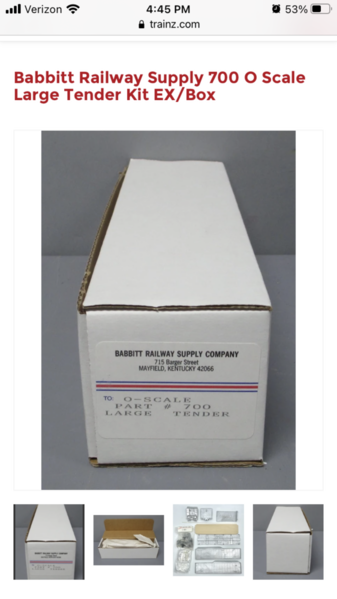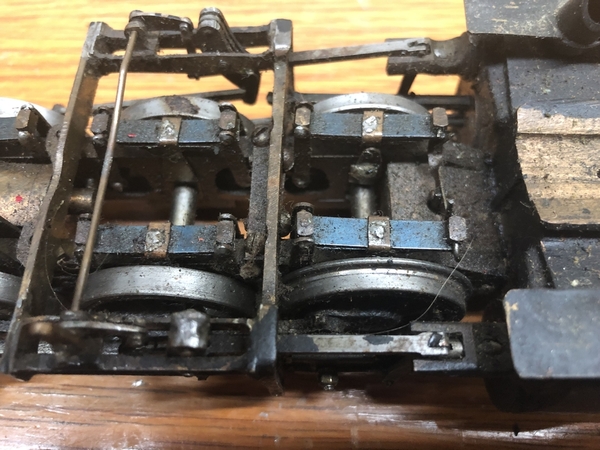 Well, I’ve just won an auction for a rough and dirty unidentified mikado! This could be interesting! Stay tuned for details…
Well, I’ve just won an auction for a rough and dirty unidentified mikado! This could be interesting! Stay tuned for details…
Replies sorted oldest to newest
I think it is Hines.
I’ll post a bunch of better pics when it gets here, I’m interested in knowing who made it…
Good luck - that's going to need a lot of work. Comparing it to pictures of Hines Mikados, it might use some Hines parts, but a lot of it looks scratchbuilt. Looking carefully at the photos on eBay, it looks like it might have properly equalized drivers - if it does, that's really neat.
Try looking for an All-Nation Medium tender, I believe they use the same exact castings as the Hines tenders did. They're pretty accurate models of USRA 10,000 gallon tenders.
Cool project! I love that ![]()
Think you've managed to acquire a good challenge there....but one that just might be very rewarding.
It certainly is a project, but that’s what I was looking for…
I’m thinking about making a series of YouTube videos on this engine…
Well, it’s on its way… FedEx said it would arrive this Saturday, then it changed to next Tuesday, now it says this Friday…
I think it might be. That tender usually is paired with the All-Nation Mountain, so it's pretty big. Maybe 25% longer than the medium tender? I don't have one on hand to compare. Fortunately the medium tender pops up on eBay quite often, so you should be able to find one. I'll keep an eye out myself.
Thanks for the input! I could possibly come up with an explanation where a railroad added a larger tender… WMSR 734 for example, that’s a consolidation (admittedly a rather large one) with a 6 axle tender and it doesn’t look out of proportion to me…
The other side of the coin is that I might want to try to model a GTW mike and the medium tender would probably be more appropriate for that…
And then I have a decal sheet left over from my Railking NKP Berk renumber project that has enough left to do this up as the NKP 587… and that had a pretty big tender, at least in excursion service… (edit- the more I look at pics of the 587 the less I like the big tender, it overpowers the locomotive in my opinion… is that a Berk tender??)
So that’s 3 sides to the coin so far…
There was a Lobaugh tender on the Bay that would have worked.
Get some brass sheet and make what you want. Tenders are fairly easy in comparison to locomotive restoration.
Bob has a good point! I didn’t think I could hand-lay a turnout, but then I tried it, and I ended up with a working turnout…
It’s here!! And it’s awesome!
It’s fully sprung and equalized, and all of the valve gear is there!
The wiring is a mess, with a bridge rectifier that looks much newer than the engine, so I’m not sure yet if it runs… gotta figure out how to wire up the motor so if anyone has any suggestions I’m all ears…
Attachments
Nice project. Yes, NKP 587 had a Berk tender behind it during its past excursion years of use. Helped with fuel range. It first had the NKP tender that had a 3 axle under the coal bunker and 2 axle truck under the water tank, then that was swapped out for a Berkshire tender. When first built, being a USRA light Mikado, she had the typical small tender those came with, then NKP kind of swapped tenders around depending on need. Looking forward to see what you do with that old Mikado. AD
Good luck! It's a mess, but someone spent a lot of time on that. I'd start by taking photos of everything, then I'd carefully dismantle it, clean everything, then slowly put it back together making sure everything gets a drop of oil. As long as the wheels turn freely and the rods don't bind, I'm sure it runs - those old motors are hard to kill. I personally prefer to have gone through everything, making sure everything is free, before trying to run anything.
Any tips on cleaning? Solvent/detergent recommendations? I don’t want to damage the insulation in the wheels…
Also- I’ve been doing some reading on field-wound motors and I’m unsure if the field is supposed to be series or shunt(parallel)…
For most parts, you can just wash them in hot soapy water and lightly scrub with a toothbrush. It's important to dry everything off quickly, I typically just set parts in front of a fan to dry. I would only wash parts like that if it's completely dismantled, that way everything can dry properly and you can reach everything. For the motor, I might wash removable parts in water, but not the field or armature. I normally clean the commutator and brushes with cotton swabs soaked in isopropyl alcohol, and use toothpicks to clean out the grooves.
I think this motor should be series. You would reverse the polarity of the brushes or the field to reverse, both would work. I think reversing the field is more common. Unless this locomotive has a reverse switch or reverse unit, it's forward (or reverse, if wired that way) only. I don't know why it would have a rectifier, that motor should run on AC or DC, it's only when trying to run a DC motor on AC is it necessary.
Thanks! I think the rectifier is a relatively recent addition… it certainly doesn’t match the “patina” of the engine. I’m guessing someone was attempting to make it run and didn’t know what they were doing…
I’ve seen videos of vintage O scale outside 3rd rail engines with a “reverse” switch somewhere on the engine. Apparently those would reverse the polarity of the field, thereby reversing the motor rotation… From my (limited) research/knowledge I don’t see a way to change the direction of the motor “remotely”…
Yeah, a switch like that would be what you would typically find on an engine like this, though a reverse unit, like in most 3-rail engines, would work. I don't know if a reverse unit would tolerate DC though.















